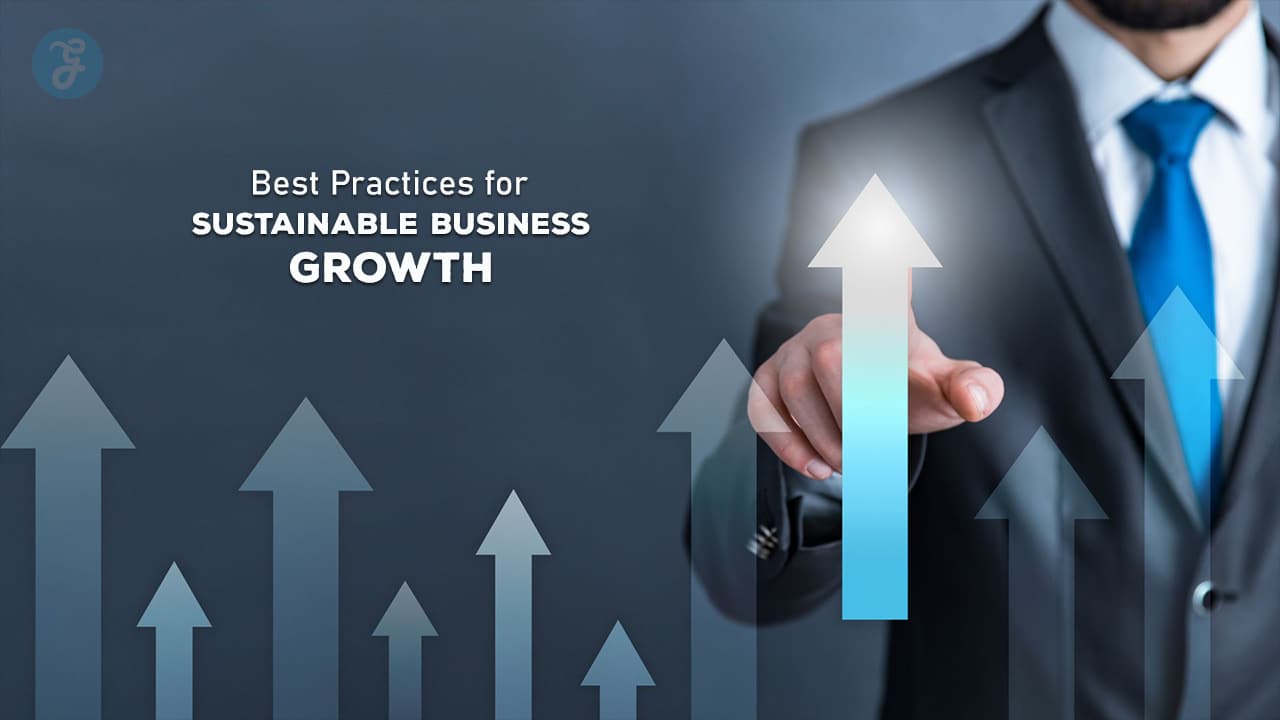Growth is often seen as the ultimate goal in today’s fast-paced business world. But not all growth is created equal.
Sustainable business growth – the kind that lasts and benefits the company and its stakeholders – requires careful planning and execution.
This article explores ten best practices that can help businesses achieve sustainable growth over the long term.
What is Sustainable Business Growth?
Sustainable growth goes beyond just increasing revenue or market share. It involves building a resilient organization that can weather economic storms, adapt to changing market conditions, and create lasting value for customers, employees, and society.
By following these best practices, businesses can lay a solid foundation for long-term success, balancing short-term gains with long-term sustainability.
These practices cover various business aspects, from strategic planning and customer focus to financial management and corporate responsibility.
They are based on the experiences of prosperous businesses from a variety of industries and have the support of research in organizational behavior and business management. While every business is unique, these principles can be adapted to fit different contexts and scales, from small startups to large corporations.
As we delve into each practice, we’ll explore the what, why, and how – providing practical insights and examples to help businesses implement these strategies effectively.
Let’s begin our journey towards sustainable business growth.
1. Develop a Clear Vision and Strategy
Developing a clear vision and strategy is the first step towards sustainable business growth. This involves defining where you want your business to be in the future and mapping out how to get there.
A strong vision serves as a guiding star for your organization. It should be inspiring and ambitious yet achievable. Your vision might be to become the industry leader in customer satisfaction, to revolutionize your sector through innovation, or to be the most sustainable company in your field.
Once you have a vision, you need a strategy to make it a reality. This strategy should outline your long-term goals and the critical steps required. It should consider your company’s strengths and weaknesses, as well as external factors like market trends and competition.
Research shows that companies with clearly articulated visions and strategies outperform those without them. A study by Bain & Company found that companies with clearly defined visions and strategies grew 30% faster than their competitors over five years.
To develop a compelling vision and strategy:
- Involve critical stakeholders in the process.
- Conduct a thorough analysis of your current position and market.
- Set specific, measurable, achievable, relevant, and time-bound (SMART) goals.
- Communicate your vision and strategy clearly to all employees.
- Regularly review and adjust your strategy based on performance and changing conditions.
2. Focus on Customer Value
Sustainable business growth is impossible without a strong focus on customer value. This means understanding your customers’ needs and consistently delivering products or services that meet or exceed their expectations.
Customer-centric companies are more likely to achieve sustainable growth. According to a study by Deloitte and Touche, customer-centric companies were 60% more profitable than those not focused on the customer.
To focus on customer value:
- Understand your customers: Conduct regular market research to understand your customers’ needs, preferences, and pain points.
- Deliver quality: Ensure your products or services are high quality and consistently meet customer expectations.
- Provide excellent customer service: Train your staff to provide outstanding customer service at every touchpoint.
- Seek feedback: Regularly collect and act on customer feedback to continuously improve your offerings.
- Personalize experiences: Use data and technology to provide personalized experiences that make customers feel valued.
- Innovate based on customer needs: Use customer insights to drive product or service innovation.
By focusing on customer value, you retain existing customers and attract new ones through positive word-of-mouth. This leads to sustainable growth as satisfied customers become loyal brand advocates.
3. Invest in Your People
Your employees are your most valuable asset. Investing in their development and creating a positive work environment is crucial for sustainable business growth.
Companies that invest in employee development see significant returns. A study by IBM found that organizations that invest in employee training see 24% higher profit margins than those that don’t.
Here are key ways to invest in your people:
- Provide ongoing training and development opportunities.
- Offer competitive compensation and benefits.
- Create a positive company culture that values employee well-being.
- Recognize and reward good performance.
- Promote from within when possible.
- Encourage open communication and feedback.
Investing in your people leads to higher employee satisfaction and retention, better customer service, increased productivity, and sustainable business growth.
4. Embrace Innovation and Adaptability
In today’s rapidly changing business environment, innovating and adapting is crucial for sustainable growth. Companies that fail to evolve risk becoming obsolete.
Innovation doesn’t always mean inventing new products. It can also involve improving processes, finding new ways to serve customers, or adopting new technologies to increase efficiency.
Adaptability is equally essential. Markets change, new competitors emerge, and customer preferences evolve. Businesses that can quickly adapt to these changes will likely thrive in the long term.
To foster innovation and adaptability:
- Encourage a culture of creativity and experimentation.
- Stay informed about industry trends and emerging technologies.
- Be open to change and willing to pivot when necessary.
- Allocate resources for research and development.
- Learn from failures and view them as opportunities for growth.
Companies that prioritize innovation and adaptability often see significant growth. For example, Amazon’s willingness to experiment with new business models (like AWS) has been a critical driver of its long-term success.
5. Practice Financial Discipline
Financial discipline is crucial for sustainable business growth. It involves managing your resources wisely, controlling costs, and making smart investments.
To practice financial discipline:
- Create and stick to a budget.
- Monitor cash flow closely.
- Manage debt wisely.
- Invest in growth opportunities that align with your strategy.
- Maintain a financial buffer for unexpected challenges.
A study by PwC found that companies with strong financial discipline outperformed their peers by 55% over three years.
Remember, growth at any cost is not sustainable. Sometimes, slower, profitable growth is better than rapid, unprofitable expansion.
6. Build Strong Partnerships
No business is an island. Building strong partnerships with suppliers, distributors, and competitors can drive sustainable growth.
Strong partnerships can:
- Expand your reach to new markets.
- Provide access to new technologies or expertise.
- Help you achieve economies of scale.
- Increase your competitive advantage.
A Business Performance Innovation Network study found that 54% of businesses that prioritized partnerships saw growth rates of 20% or more.
When building partnerships, look for organizations that share your values and have complementary strengths. Clear communication and mutual benefit are essential to successful partnerships.
7. Prioritize Sustainability and Social Responsibility
In today’s world, businesses are expected to do more than make profits. Customers, employees, and investors increasingly favor companies prioritizing environmental sustainability and social responsibility.
Sustainable practices can lead to cost savings, increased customer loyalty, and improved brand reputation. For example, Unilever’s sustainable living brands grew 69% faster than the rest of its business in 2018.
To prioritize sustainability and social responsibility:
- Reduce your environmental footprint.
- Implement ethical business practices.
- Engage in community outreach programs.
- Ensure fair labor practices throughout your supply chain.
- Be transparent about your efforts and progress.
8. Leverage Data and Analytics
Data is a powerful tool for driving sustainable growth in the digital age. Businesses can make more informed decisions, optimize operations, and better understand their customers by leveraging data and analytics.
According to a study by McKinsey, companies that use customer analytics comprehensively see a 126% profit improvement over competitors.
To effectively leverage data and analytics:
- Invest in data collection and management systems.
- Train your team in data analysis.
- Use data to inform decision-making at all levels.
- Protect customer data and respect privacy regulations.
Remember, the goal is to collect data and derive actionable insights that drive growth.
9. Expand Strategically
Expansion is often a crucial part of growth, but it needs to be done strategically to be sustainable. This could mean entering new markets, launching new products, or acquiring other businesses.
Strategic expansion should:
- Align with your overall vision and strategy.
- Be based on thorough market research.
- Consider your company’s capabilities and resources.
- Balance risk and potential reward.
A Harvard Business Review study found that companies that expand in a controlled, strategic manner are 40% more likely to survive and prosper.
10. Cultivate a Growth Mindset
Finally, sustainable business growth requires cultivating a growth mindset throughout your organization. This means viewing challenges as opportunities, valuing learning and improvement, and believing in the growth potential.
Companies with a growth mindset are more innovative, adaptable, and resilient. They’re better equipped to navigate challenges and seize opportunities.
To cultivate a growth mindset:
- Encourage continuous learning and development.
- Celebrate effort and progress, not just results.
- View failures as learning opportunities.
- Foster a culture of open communication and feedback.
Research by Carol Dweck, who coined the term “growth mindset,” shows that organizations that foster a growth mindset see significantly better employee engagement and innovation.
Final thoughts
Sustainable business growth is not about quick wins or short-term gains. It’s about building a resilient, adaptable, and responsible organization that can thrive long-term.
Remember, these practices are not one-time efforts but ongoing commitments. They require consistent focus, effort, and adaptation. But the rewards – a thriving, sustainable business that creates value for all stakeholders – are well worth it.
As you implement these practices, remember that every business is unique. Adapt these principles to fit your specific context, industry, and goals. With persistence and the right approach, sustainable growth is within reach for businesses of all sizes and sectors.











































